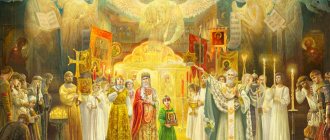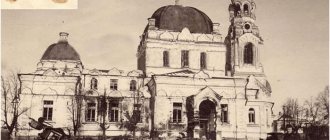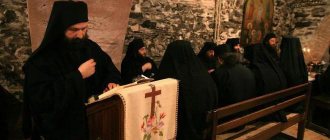Christianization of Novgorod
It is worth recalling that even before Vladimir, the princess of Novgorod was Olga - also, by the way, a saint canonized by the Orthodox Church. And not just a saint, but equal to the apostles. And this means in the Christian understanding that she was a missionary, the first educator of the Slavs. And more specifically, the Novgorodians.
Moreover, if we turn to Kartashov’s “Essays on the History of the Russian Church,” the chronicles give an incorrect, somewhat later chronology of Olga’s own baptism. At the time of her trip to Constantinople, she most likely already professed Christianity: “It is very significant that “Presbyter Gregory” does not appear among the translators or among the crowd of other deputies.
It is obvious that the modest but emphasized figure of the priest in Olga’s retinue indicates either that Olga was already baptized and Gregory was her confessor and court chaplain.” Or, at a minimum, Olga was actively preparing to be baptized and “Presbyter Gregory” was her catechist.
One way or another, the Christianization of Novgorod began several decades before the Baptism of Rus'. And the Novgorod pagans did not experience any special rejection towards the Novgorod Christians. Moreover, after the Baptism of Rus' in Novgorod, Christianity was preached relatively freely and calmly. And, judging by the same Kartashov, Novgorod at the dawn of the Christianization of Russian lands was perceived as one of the strongholds of Orthodoxy.
But Novgorod was a very free city, and already in 990-991, when the small squad of governor Vladimir, Dobrynya, was approaching the city, a veche was assembled. At which the Magi and “city fathers” spoke out both for paganism and for complete and absolute disobedience to Kyiv and the power of Vladimir Krasno Solnyshko.
In essence, it was a political act, where religion was, although a powerful, pretext. Let us recall again that Christianity spread and existed calmly in Novgorod even before the Baptism of Rus', under Princess Olga.
The Baptism of Rus' is a grandiose political deception!
Home / The Past of the Slavs / The Baptism of Rus' is a grandiose political deception! /
A most interesting quote from the book by Alexander Bushkov. "The Russia that never existed"
HOW WAS Rus' BAPTIZED?
The question mark appeared here by no means by accident. The classic version of this epoch-making event has been known for a long time: Princess Olga was baptized according to the rite of the Byzantine church in Constantinople, where the Byzantine emperor, captivated by her beauty, initially invited the Kiev princess to become his wife, but the cunning Olga said: since the emperor had become her godfather, marry It is inappropriate for him, the emperor, to be a goddaughter. The emperor was ashamed and retreated. Olga returned to Kyiv. Her son Svyatoslav did not show any desire to follow his mother’s example and remained a pagan, like his son, the famous Vladimir. Only later, when neither Olga, nor Svyatoslav, nor Vladimirov’s brother the Christian Yaropolk (who was killed by Vladimir’s people) were no longer alive, Vladimir summoned Muslims, Jews, Roman Christians, Byzantine Christians to Kiev and, after listening to the arguments of each in defense of his faith, settled on Byzantine Orthodoxy...
This canonical version is based on one single source: the so-called “Tale of Bygone Years,” and it is considered the most terrible heresy in scientific circles if anyone dares to doubt the authenticity of this “Tale” - or to doubt its dating (it is generally accepted that the “Tale "Completed by the wise chronicler Nestor in 1106).
It would be good for us, brothers, to begin a detailed analysis of this...
Let's start with Nesterov's work. The first study of the “Tale of Bygone Years” in Russia was undertaken by the German scientist August Ludwig Schlozer, (1735-1800), a historian and philologist who was in Russian service in 1761-1767. and chosen as an honorary foreign member of the St. Petersburg Academy of Sciences. But what should be of interest to us is not Schletser’s research itself, but what he writes about the activities of the Russian historian and statesman V.N. Tatishchev (1686-1750):
“In 1720, Tatishchev was sent to Siberia... Here he found a very ancient list of Nestor from a schismatic. How surprised he was when he saw that he was completely different from before! He thought, as I did at first, that there was only one Nestor and one chronicle. Tatishchev little by little collected a dozen lists, and based on them and other options communicated to him, he compiled the eleventh..."
Curious, isn't it? It turns out that two hundred years ago there were still a dozen different “chronicles of Nestor” - and in addition some “other options”... Today, from all this diversity, there is only one canonical text left - the same one that we are led to think was written in 1106 and is the only correct one...
What’s even more curious is that Tatishchev never managed to publish the results of his work. In St. Petersburg, “strange objections” arose regarding the publication (Schletser’s definition). Tatishchev was directly told that he could be suspected of political freethinking and heresy. He tried to publish his work in England, but this attempt was also unsuccessful. Moreover, Tatishchev’s manuscripts subsequently disappeared. And the “History” attributed to Tatishchev, as academician Butkov pointed out at the beginning of the 19th century, was not Tatishchev’s original, but a very free transcription, practically rewritten by the well-known Gerard Miller, a German in Russian service: Tatishchev’s “History” was not published from the original, which is lost , but from a very faulty, thin list... When printing this list, the author’s judgments, recognized as free, were excluded from it, and many editions were made.”
One can also add that Tatishchev himself did not trust the “Tale of Bygone Years” at all, about which he wrote directly: “Nestor the monk has no good knowledge about the ancient Russian princes.”
What allowed Tatishchev to make such a categorical statement? Exactly unknown. “Other options” of Nestor have disappeared, like the papers of the Kazan and Astrakhan archives, in which Tatishchev worked... However, one should not give up - not everything, but a lot can be restored indirectly.
Olga's trip to Constantinople actually took place. There is no doubt about this for one single, but extremely compelling reason: there is an official description of Olga’s reception at court, “De Ceremoniis Aulae Bizantinae” - and this work belongs to the most authoritative witness, the Byzantine Emperor Constantine VII Porphyrogenitus himself. In fact, in 957 the emperor received the Kyiv princess with all honor. But there was no way he could become her godfather - because he writes in black and white that Olga was already a Christian! And in the princess’s retinue was her confessor! By the way, there was a very prosaic reason why Konstantin could not offer Olga his hand and heart - by the time she arrived, he was already legally married...
Truly, you begin to believe Tatishchev that Elder Nestor was “mistreated”!
There is no reason not to believe Emperor Constantine. In those days, pagan Rus' caused Byzantium a lot of trouble and anxiety with its frequent raids, after which the proud Romans paid considerable tribute to the Slavs. There is no doubt: Olga’s acceptance of baptism in Constantinople by the Byzantines would, by any criteria, be such a stunning diplomatic and political success for Byzantium that it should not only have been mentioned, but loudly announced to the rest of the world.
However, they did not report. They honestly wrote that Olga arrived already baptized...
Who baptized her? And when? Finally, why did we decide that Olga was baptized according to the Byzantine rite? Perhaps, on the contrary, in “Latin”, that is, Roman? I can already see how the fists are clenched and I hear the teeth of the zealots of the Orthodox version gnashing. However, contrary to established opinion, I am not inclined to rely on it just because it is established. After all, for centuries they believed the established belief that the Earth revolves around the Sun...
It turns out that there has long been an assumption that Olga actually received baptism in Kiev, in 955. It turns out that by that time there was already a Church of St. Elijah in Kyiv (whose affiliation with the Patriarchate of Constantinople has not yet been proven). It turns out, according to Western European chronicles, in 959 Olga’s ambassadors arrived to the German Emperor Otto, ASKING FOR THE SENDING OF A BISHOP AND PRIESTS TO RUSSIA! The request was accepted, and the following year, 960, a certain monk of the St. Alban Monastery was ordained bishop of Rus', but could not arrive in Kyiv because he fell ill and died. In the same year, Adalbert, a monk of the monastery of St. Maximin in Trier, was ordained bishop of Rus' - and reached Kiev. True, a year later he had to leave Russian borders. Why? Supporters of “non-storism” are unable to refute the very arrival of Adalbert to Rus' (for not only Western European, but also Russian chronicles write about this), but they declared his departure as “the Russians’ rejection of the Papage guest.” That is, another argument in favor of the “Byzantine” version of Olga’s baptism.
Meanwhile, Adalbert’s departure from Kyiv can be interpreted in another way. Perhaps the point was not that Adalbert came from the pope, not at all... After all, in those days the united Christian church had not yet split into Orthodox and Catholic, and therefore we can rightfully conclude that the violent attacks of Nestor’s The “Tales” addressed to the papists are precisely explained by the fact that the “Tale of Bygone Years” was written in the sixteenth century, when the confrontation truly became irreconcilable. And in the Church of St. Sophia, built in Kyiv in the 12th century, the mosaic image of Pope Clement calmly coexisted with the images of Gregory the Theologian and John Chrysostom...
Adalbert could have left Kyiv for reasons, as we would put it now, of an organizational nature. Historian M.D. Priselkov believed that Adalbert was sent to Kyiv with limited powers - the Russian church was to be organized as a simple diocese, that is, subordinate directly to the German clergy. Olga could well have demanded that the Kiev church become an autonomous unit under the leadership of an autonomous bishop or metropolitan. In any case, these were the demands that were once put forward by the rulers of Poland and the Czech Republic who adopted Christianity from Rome - and after a long, difficult struggle they achieved their goal. Olga could simply follow their example. But we didn’t agree. Adalbert had to leave in a hurry. Subsequently, his departure was interpreted as Kiev’s “rejection” of the “Roman option.”
Was there such a rejection? Let me doubt...
ABOUT CONSTANTINE AND METHODIA
The spread of Christianity in Rus' is inextricably linked with the names of two enlightenment brothers - Cyril and Methodius. It was they who compiled the Cyrillic alphabet - a new alphabet that replaced the old Slavic letters, and this alphabet from Moravia and the Czech Republic came to Rus'. Of course, it has long been customary to call the brothers “Orthodox of the Byzantine rite”...
However, everything was somewhat different. Firstly, according to logic, the alphabet should have been called not Cyrillic, but Constantine - because Methodius’s brother was called Constantine, and he adopted the name Cyril shortly before his death, having entered a monastery. By that time, the new Slavic alphabet had long been compiled by him and his brother...
Secondly, the entire life and activity of the brothers indicate that they were, first and foremost, envoys of Rome. Judge for yourself.
At first, Constantine and Methodius actually lived in Constantinople - and were not yet priests, but learned lay scribes. In 862, Prince Rostislav, who ruled Great Moravia, came to the Byzantine Emperor Michael and told him that Moravia had renounced paganism, began to observe Christian law, but did not have teachers who would preach the Christian faith in the Slavic language.
It was then that the emperor entrusted the learned brothers with a responsible mission. Having compiled a new alphabet, Constantine and Methodius arrived in Moravia and preached Christianity there for more than three and a half years, disseminating the Holy Scriptures written in the same Cyrillic alphabet (Constantinian alphabet).
After which they intended to return to Constantinople... but, having met a papal messenger in Venice who invited them to Rome, they followed him. It was in Rome that Pope Adrian II ordained the brothers to the priesthood! A letter from the pope to the Moravian princes Rostislav, Svyatopolk and Kotzel has been preserved, which, in particular, says: “We, having experienced triple joy, decided to send our son Methodius, ordaining him and his disciples, to your lands, so that they would teach you as you asked , translating the Scripture into your language, and would perform the full rites of the church, and the holy liturgy, that is, the service of God, and baptism, begun by the grace of God by the philosopher Constantine.”
There is no talk of enmity between the Western and Eastern churches yet - in the same message, Adrian calls the Byzantine emperor “pious.” There is another significant mention: Constantine and Methodius, going to Moravia, knew in advance that these lands belonged to the “apostolic”, that is, the Roman canon. And therefore they did not deviate in the slightest from the Roman canons. And the relics of Saint Clement they found were taken not to Constantinople, but to Rome.
It only remains to add that the pope subsequently made Constantine a bishop, and also specially restored the Srem metropolis for Methodius.
So, at the end of the 9th century, in the Slavic lands, with the blessing of the Pope, through the works of Constantine and Methodius, apostolic Christianity spread, i.e. Roman canon. It spread among Rus''s closest neighbors, the related Slavs. Perhaps this is where the emergence of Christian churches in Kyiv and Olga’s baptism originated? Does Constantinople have anything to do with it at all? Only later, when relations between Rome and Constantinople deteriorated completely and things came to the point of mutual anathematization, chroniclers like Nestor (who most likely lived in the 15th or 16th centuries) tried their best to erase all “seditious” references to baptism, originally received from envoys of Rome...
There is another indirect evidence. The presence in our Holy Scripture of the Third Book of Ezra, which is present only in the Vulgate (Bible in Latin) - but not in the Greek and Hebrew versions of Scripture. This proves: the first translations of the Bible into Old Church Slavonic were made precisely from the Vulgate, that is, from the Bible of the Roman canon. And the calendar - the basis of worship - in Rus' was not adopted by Byzantine, but rather Latin. The names of the months are Latin, not Roman, and the beginning of the year was considered not September, as among the Greeks, but March, as in the West...
I wonder if there are Western European sources confirming this heretical hypothesis?
Imagine there is. This is what the chronicle of the Franciscan monk Adhemar (12th century) reports: “Emperor Otto III had two most venerable bishops: Saint Adalbert and Saint Brun. Brun humbly retreats to the province of Hungary. He converted the province of Hungary and another, which is called Russia. When he reached out to the Pechenegs and began to preach Christ to them, he suffered from them, just as Saint Adalbert suffered. The Russian people bought his body at a high price. And they built a monastery in his name in Russia. After a little time, some Greek bishop came to Russia and forced them to accept the Greek custom.”
Russian historiography reluctantly admits Brun's trip to the Pechenegs. However, everything else written by Adhemar is refuted by modern pundits using the hackneyed method: “the chronicler was mistaken.” From the twentieth century it is clearer. Nestor should be considered the most truthful person under the sun. Ademar should be considered an ignorant person who put unreliable gossip and unverified rumors on paper. Nestor fits into the concept, but Ademar is categorically inconvenient...
That's how they live. Adding in passing that Princess Olga burned the city of Korosten... with rockets received from the Byzantines. The proof is precisely that there is not a single mention of this in Byzantine documents - which means that secrecy was strictly observed...
DEATH ON THE DNIEPR
Many historians have long agreed that the murder of Prince Svyatoslav by the Pechenegs at the Dnieper rapids is a much more complex and mysterious story than the official version, according to which Svyatoslav, returning after the war with the Romans, purely by chance ran into superior forces of the steppes. So here I am not opening any Americas. Bye…
The story is indeed mysterious and dirty. Judge for yourself. After battles that lasted two months at the Bulgarian fortress of Dorostol, Svyatoslav concluded, in general, a rather honorable peace with the Byzantine emperor John Tzimiskes. And he sailed with his squad to Kyiv in late autumn. According to the chronicles, the Russians learned that the Pechenegs had ambushed them at the rapids...
And here something happens! Something that will forever remain a mystery. Most of the squad, led by Voivode Sveneld, leaves for Kyiv overland, along the steppe - and safely reaches the city!
As for Prince Svyatoslav, he suddenly begins to behave more than strangely. The smaller part of the squad remains... to spend the winter either on the shore or on one of the Dnieper islands. The winter was fierce, there was almost no food, the chroniclers emphasize that the Russians were in unspeakable poverty: “... they paid half a hryvnia for a horse’s head, disease was the enemy.” In the spring, Svyatoslav, without even trying to cross the steppe along which Sveneld had safely left, again sails along the Dnieper. The Pechenegs, strangely enough, spent the winter here for some reason - they are still lying in wait for the prince. And they kill...
Strangeness is beyond acceptable. Why didn’t Svyatoslav go to Kyiv through the steppe? Does Sveneld's departure mean that a split has occurred in the Russian camp? Why did the Pechenegs wait so stubbornly for several months? History does not seem to record any actions of Svyatoslav that inspired the Pechenegs with an irresistible desire to take revenge on the prince for something...
Dark story. And that’s why it was called “contract murder” more than once. The complete impression is that Svyatoslav understood perfectly well: he could not go to Kyiv. Why? What could have happened there? At first, the Byzantines were blamed for everything, who allegedly bribed the Pecheneg Kagan Kurya. However, it was later brilliantly proven that the Romans simply did not have enough time to organize a rather complex operation. They would not have had time to communicate with the Pechenegs...
Then? The late L.N. Gumilyov proposed a rather elegantly constructed version. According to it, the conspiracy against Svyatoslav was started by Svyatoslav’s eldest son Yaropolk, who stood at the head of the Kyiv Christians. In other words, the growing Christian party thus got rid of one of its most influential opponents. Fortunately, the Kiev governor Pretich was at hand, several years earlier he had become a sworn brother of the Pecheneg Kagan Kuri - he, most likely, became the “connector” [48].
Indirect confirmation of this version is the Joachim Chronicle, where the death of Svyatoslav is declared to be God's punishment for the fact that the prince dealt with Kyiv Christians in 971 and ordered the destruction of a certain church.
In fact, the Joachim Chronicle has long been recognized as a compilation source compiled in the 17th century, which “cannot be trusted without verification” (Academician B. Rybakov). The academician himself believed that the evidence was the pedestal of the pagan god in the center of Kyiv, which “was paved with plinth and frescoes of a Christian temple destroyed before 980” [168].
True, the “proof” cited by Academician Rybakov only testifies that the Christian temple was once destroyed, but not that Prince Svyatoslav was to blame for the destruction... The reader has the right to exclaim in bewilderment: “Excuse me! After all, it is reliably known that Svyatoslav, unlike his mother Olga and eldest son Yaropolk, was an adherent of paganism!”
That's right, it's known. From Nestor's manuscript. But in recent years, evidence has appeared that makes us once again remember the characterization given to Nestor Tatishchev...
In their recently published book “Empire,” Moscow mathematicians Nosovsky and Fomenko, known for their most interesting works on the topic of “new chronology,” cited large excerpts from Mauro Orbini’s book on Slavic history. This book was first published in 1601, and its author, “Archimandrite Raguzhsky,” was based on a huge number of medieval sources that simply have not reached our time [139].
By the way, I personally do not agree with Nosovsky and Fomenko that the definition of “Archimandrite of Raguga” connects Orbini’s personality with the Balkan or Italian city of Ragusa. Another version also has a right to exist: Orbinn was an Austrian. The word “Ragussky” could well mean a distorted “Rakussky” - that is, “Austrian”. In old Russian books, the title “Prince of Artsy Rakus” is used to refer to the German Emperor Maximilian, who in fact had the Duchy of Austria among the lands under his control. And in modern Czech and Slovak, Austria is called “RAKOUSKO”... But let’s return to Svyatoslav. In Orbini’s book, I came across a most curious line: After Olga’s death, her son Svyatoslav ruled, WALKING IN THE FOOTSTEPS OF HER MOTHER IN PIONANCE AND CHRISTIAN FAITH .” What's it like? This means that in the past, in addition to the “Nestor” that stuck in the teeth, there were other sources that viewed Prince Svyatoslav somewhat differently than the “Nestorites.” What other conclusion can be drawn from the above quote?
In fact, it turned out somewhat strange: Svyatoslav’s mother is a zealous Christian, the eldest son is a zealous Christian, but he himself is a pagan... Cut my head, but there was some kind of psychological inconsistency here.
If Orbini’s message is true (and what grounds do we have to a priori consider it false, giving preference to Nestor?) and Prince Svyatoslav was a Christian, the events on the Dnieper can be interpreted somewhat differently...
Svyatoslav remains to winter on the Dnieper, because he is well aware of the threat threatening him from Kyiv - but this threat comes not from the Christian party of Yaropolk, but from the pagan Vladimir. Sveneld, who abandoned Svyatoslav, and, possibly, Pretich belong to this group. An anti-Christian coup is being prepared in Kyiv, and therefore Svyatoslav, as a zealous and influential supporter of Christians, must be removed...
And they remove it - with the hands of the Pechenegs. The name of their kagan is present in different interpretations - Kurya, Kurey, Kur... It is interesting to note that in the Turkic language there is the word “Kur”, which is usually used to call a one-eyed person - someone who has lost one eye as a result of injury, or a white-faced person. Perhaps the “people of Kagan Kuri” are actually the “Crooked Gang”?
By the way, some sources claim that Svyatoslav was killed on the banks of the Dnieper, and on the island of Khortitsa.
According to the testimony of the already mentioned Constantine Porphyrogenitus, on this island, near a huge oak tree, the pagan Rus performed their sacrifices by killing live roosters. The work of modern archaeologists fully confirms this message.
I wonder if there is any connection between the violent death of the Christian Svyatoslav and the pagan sanctuary located near the place where the prince was killed? Perhaps it was no coincidence that his blood was shed on Khortytsia? Sacrifice?
And finally, there is a chronicle where it is directly stated that Svyatoslav did not forbid his people to be baptized - “not a harrow”...
All subsequent events fit without the slightest stretch into the hypothesis about the Christian Svyatoslav.
Vladimir kills his brother, Christian Yaropolk. And he sets up a famous pagan sanctuary in Kyiv, about which too much has been written (and therefore there is no point in citing indisputable sources here). Perhaps it was on the orders of Vladimir (even certainly within the framework of our version) that Christian church, whose stones and frescoes lay on the pedestal of a grandiose pagan temple, was destroyed. Who needed to turn Svyatoslav into an inveterate pagan is easy to guess. Subsequently, when apologetic descriptions of the “life of St. Vladimir” began to be written in large numbers, the Christian Svyatoslav seemed to become inconvenient. The main credit for the baptism of Rus' should have gone to Vladimir. It was then, presumably, that the censor’s scissors went through the chronicles that did not fit into the official canon. Any mention of the initial adoption of baptism by Russia from the envoys of Rome was destroyed (although the hands were too short to reach Western European documents like the chronicle of Adhemara). The figure of Svyatoslav, who persisted in his pagan errors, perfectly set off the bright image of Vladimir the Baptist. I suspect that the rulers of history would have done the same metamorphosis with the greatest pleasure with Princess Olga. However, here it was necessary to observe a minimum of decency - there was too much evidence of her belonging to Christianity, and the ashes of the princess rested in the Church of the Tithes, from where it would have been difficult to remove them. But Svyatoslav, who died somewhere far away, was perfectly suited to the role of “defender of paganism,” fortunately there was no one to protest. And the treacherous murder of Yaropolk... A certain historian declared the prince “vindictive and envious.” Without explaining, it is clear on what basis I came to this conclusion. The main thing is that you don’t seem to feel sorry for the vindictive and envious.
I wonder if the moment will ever come when, not privately, but with wide publicity, they will pay tribute to the memory of the Christian martyr Svyatoslav, who died at the hands of the pagans for the faith? Or will “non-storing” continue to triumph?
AND THE MISSIONARIES CAME...
In order to properly assess the “truthfulness” of Nestor’s chronicle, “The Tale of Bygone Years,” and also to prove that it could in no way be compiled in 1106 (the year 1606, or even later - it would be much more accurate), we will consider in detail one of the key episodes of this creation: a story about the events that allegedly occurred before Vladimir adopted Christianity.
According to Nestor, first, one after another, as if by some kind of preliminary agreement (a completely impossible thing!), certain envoys professing one faith or another come to Vladimir: Muslims, “Germans from Rome,” Jews and Greeks. The Muslim begins:
“And Vladimir asked: “What is your faith?” They answered: “We believe in God, and Mohammed teaches us this: to perform circumcision, not to eat pork, not to drink wine, but after death, he says, you can commit fornication with your wives.” And then they inform the prince: it turns out that even in this earthly life, one can “indulge in all fornication without restraint” [173].
What's it like? Can you imagine a zealous missionary who, in preaching to the pagans, mainly emphasizes the fact that his faith allows him to “indulge in all fornication without restraint”? Personally, I'm somehow not able to. Either this missionary is a complete fool and a debauchee (would they send such a person to such a responsible mission?), or this whole story was invented from beginning to end much later than the events described, when hostility between Orthodoxy and Islam reached a high intensity (which simply could not have happened) in the 10th century AD).
With the “Germans from Rome” the situation is even more anecdotal. In defense of their faith, according to Nestor, they were able to mumble one single tongue-tied phrase: “Fasting according to strength; if anyone drinks or eats, then all this is for the glory of God, as our teacher Paul said.”
Of course, our “eyewitness” is lying, like Nestor... But what should be of interest to us is not the nonsense that Nestor put into the mouths of the “Germans”, but the very use of this word - “Germans”, which irrefutably proves that the “Tale” was composed no earlier than the sixteenth century. It was at that time that the word “German” came into use in Russia, which served to designate any Western European. In the Middle Ages in Rus', Western Europeans were called completely differently: “Fryaz” or “Latin”. For example: in 1206, having learned about the capture of Constantinople by the crusaders, the Russian chronicler entered this news on the tablet in the following form: “... Constantinople was conquered and partly burned by the Fryagams and, or Latins.” And there are many similar examples...
Following the Mohammedans and “Germans”, it was the turn of the Jews to experience the murderous wit of Prince Vladimir. “Vladimir asked them: “Where is your land?” They said: “In Jerusalem.” He asked again: “Is she really there?” And they answered: “God was angry with our fathers and scattered us across various countries, AND GAVE OUR LAND TO THE CHRISTIANS.”
It was not for nothing that I highlighted the last words. It is in them that the Achilles heel of “The Tale” lies. According to the dating, which, in general, is not in doubt, this interesting conversation took place in 986 from the birth of Christ.
That is, at a time when there were no Christians in Jerusalem, in the lands of the former Jewish state! The first crusaders appeared in Palestine only more than a hundred years after the events described - in 1096! Conclusion: “The Tale” was written no earlier than the end of the eleventh - beginning of the twelfth century (and, according to what was said above about the word “Germans,” even later).
Then, of course, the Greeks come and make a dozen-page speech, after which Vladimir, naturally, gives preference to them. But the adventures do not end there: Vladimir sends “nice and intelligent men, ten in number” - to visit Muslim lands, among the “Germans” (!), and also to see how the Greeks pray to God in Constantinople. Nice and smart men conscientiously went to the Muslim Bulgarians (they didn’t like it, of course), then they visited the “Germans” (with the same result), and finally ended up in the “Greek land”. From where they returned enchanted, which they reported to the prince in extreme admiration: “And they led us to where they serve their god, and did not know whether we were in heaven or on earth, for there is no such spectacle and such beauty on earth, and we do not know how to talk about it." Do with me what you want, but I am firmly convinced that Nestor is a filthy Russophobe. You can’t find any other definition for it. You have to really dislike your fellow countrymen in order to imagine them as complete and complete savages, who just yesterday climbed down from the trees and, with some difficulty, tore off their tails... According to Nestor, the people of Kiev in 986 AD were some kind of stupid creatures with pristinely pure brains. For the first time they heard about the existence of Islam, Judaism, the “German faith”, they had no idea about church services according to the Orthodox canon - and, having landed in a completely unfamiliar “Greek land”, they appeared as Papuans, their mouths open in front of sparkling beads...
Fortunately, the real story was completely different. By the end of the 10th century, the Russians had already communicated with the Volga Muslim Bulgarians for quite a long time, and therefore should have had some idea of Islam. And Christianity, as we remember, long ago took deep roots in Kiev, and churches existed there even before Vladimir, so to get acquainted with the “Greek faith” there was no need to send “glorious men” to distant Constantinople, spending government money...
One of my acquaintances, having become acquainted with this story, made a cynical assumption: in his opinion, “nine glorious men” calmly squandered their travel money while holed up somewhere in Kyiv, and obtained the necessary information without leaving the capital city at all. How could it be otherwise, if the church of the Byzantine rite existed calmly in Kyiv in those days?
This, of course, is a joke - our ideas about the tenth century. It is unlikely that such a number would have been possible in those days. The whole story with the arrival of missionaries of different religions and the “journey of nine glorious men” was invented by Nestor from beginning to end. The only bad thing is that it is still customary to refer to the creation of this lascivious pen as an indisputable truth. Here is the opinion of Academician B.A. Rybakova: “Nestor’s historical and geographical introduction to the history of Kievan Rus, written with unprecedented breadth and accuracy, deserves full confidence on our part.”
As for breadth, it seems to me that the venerable academician is absolutely right. But how he magically verified the “unprecedented authenticity” of Nester’s creations remains a sealed secret. For me personally, at least. No matter how much I racked my brains, I could not determine: on the basis of what sources Nestor claims that “2242 years passed from Adam to the Flood”...
Much more I like the statement of our famous historian D. Ilovaisky, who once wrote about one particularly outstanding Nestorov passage: “Here we see complete nonsense.” Exactly…
We recommend reading
Partner News
Attack on residence
The pagans were the first to show aggression, attacking Dobrynya’s residence, “destroying Dobrynya’s house, plundering his estate, beating up his wife and some of his relatives.” That is, it was the pagans who attacked the Christians. And they attacked for political reasons, and therefore the answer was given precisely in this harsh and categorical form, “with fire and sword.” And, by the way, it is worth noting that initially this very phrase: “Putyata baptized you with a sword, and Dobrynya with fire,” was a very angry, sarcastic joke from the people of Kiev addressed to the people of Novgorod.
However, this was not the last uprising against Christianity in Rus'. In 1071 in Kyiv, almost a hundred years after the baptism of Rus', a certain sorcerer appeared who began to preach the end of Rus' in five years if everyone did not return to paganism. He also campaigned for disobedience to authorities. And naturally he was captured.
In the same year 1071 (according to other sources, in the 60s of the 11th century) in Rostov and Yaroslavl, the Smerds, led by the Magi, also rebelled, and again with the murder of Christians and demonstrative disobedience to the authorities. Once again, the outcome for the rebels was a little predictable.
Constantinople baptized Rus' and other pagan peoples for security and expansion of the zone of influence
First, let's deal with the facts - that is, indisputable evidence. Why were pagan peoples baptized at all, and who did it? This was standard practice for Christian Constantinople.
The motive for this is, first of all, political: this way they expanded their zone of influence and reduced the likelihood of military conflicts. United by a common faith, the peoples became friendly.
Let's say there is an unfriendly settlement on the border, and clashes occur. What is easier - to send an army there or to peacefully resolve the issue in a reasonable way?
In the 9th century, Constantinople missionaries visited Great Moravia and Bulgaria, where they tried to convert the population to their faith.
Constantinople sent missionaries to Rus' even before 988, but with almost no results.
The conflict with Kievan Rus forced Constantinople to pay attention to it. The first missionaries were able to sow the seeds of Christianity on our lands, but the number of converts was modest, but among them were princes and boyars.
In 957, Princess Olga converted to Christianity. She dreamed of establishing a church in Rus', but did not succeed in this. Even her son, Prince Svyatoslav, showed no interest in his mother’s beliefs.
Pagans attacked Christians
In 1076, again in Novgorod there was a “pagan comeback” in the form of the same sorcerer, and again with an attack on Christians. And again with polytypical manifestos. Even earlier, in 1024, a similar story happened in Suzdal, where the Magi inspired the people to kill the “eldest child,” the aristocracy, and again under the auspices of a return to paganism. And again this uprising was harshly suppressed by Prince Yaroslav Vladimirovich - also, by the way, a saint, canonized as a “blessed one,” that is, canonized for a righteous life in Christ.
In 1091, an attempt at a similar uprising took place again in Rostov, but the sorcerer (and this after the suppression of the rebellion of 1071) was unable to incite the Rostovites to new unrest. According to Kartashov, the sorcerer “was no longer successful.” It is important to understand here that all these uprisings were primarily political in nature. Moreover, such a harsh suppression of the rebels was associated not only with the context of the era. The Middle Ages in general were a time of harsh people and harsh decisions. But the reasons were also that the pagans began their activities with riots and murders.
On the other hand, to understand how false the picture of “Christians who completely destroyed non-believers in Rus'” is, the very chronology of these riots can serve. Decades, or even a hundred years after the baptism of Rus', pagan priests moved relatively calmly around the principalities and, moreover, preached publicly.
And their preaching itself was not prohibited or suppressed exactly until the moment they called for the overthrow of state power. And this, perhaps, like nothing else, shows how tolerant Christian Rus' was towards cults.
The forced Christianization of Rus' should not cast a shadow on the teachings of Christ
It is impossible to say anything categorically about the baptism of Rus'. Yes, we see that there are political motives behind this event.
But this, in no case, cancels the value of Christianity for the human soul.
Today it has become firmly entrenched in Russian culture. Russian people predominantly grow up and are brought up in an Orthodox environment, so the origins of this fade into the background.
“The Baptism of Rus'” - a fragment of a fresco by V. M. Vasnetsov
Although in the first couple of years the authorities used rather radical methods, this was the reality of those years. It has as much in common with Christian teaching itself as the Crusades.
For an Orthodox person, it is important to share the interests of the state, history, nation and religion. Sometimes these concepts are confused, but they are independent.
Christianity has not become worse, bloodier or more aggressive from the way it came to our land.
Today we have been raised to believe in the One God, we have the opportunity to study the teachings of Christ in our own language and receive help from higher powers.
As for the realities of the past, we have to admit them. But we cannot blame them on Christianity.
The pagan way
Once in Kyiv, the still very young prince, and he was then about 20 years old, begins to carry out reforms.
The task of primary importance for him was the unification of the Slavic tribes. For this purpose, he carries out a religious reform, believing that one people should have the same gods, erects a pagan temple, and places a wooden Perun and other idols in the capital.
Some historians are generally inclined to believe that there was another reason for this behavior. Allegedly, Yaropolk was a Christian and even partially affirmed this faith in Rus'. When Vladimir came, he wanted to erase from the memory of the people everything that his older brother was striving for. If this is true, then Prince Vladimir failed to destroy anything. At least with Christianity.
Until 987, the ambitious ruler, together with his retinue, actively expanded the borders of his state and replenished the budget thanks to successful campaigns. The prince sealed particularly successful deals or truces with marriages. So he got two more wives.
But a fateful decision for the ruler and all of Rus' - the adoption of Christianity - came in 988, and it was connected with Byzantium.
Eastern Christianity for Russia—God's providence or calculation?
In the chronicles you can find an interesting story about how the Kiev prince sends ambassadors to different countries to choose a suitable religion for his state. Before this, both Jews and Muslims, envoys from the Pope and the Patriarch of Constantinople, came to him.
At this time, the Christian Church had not yet divided, so Orthodoxy and Catholicism were not yet officially discussed. But nevertheless, East and West were already different.
Christianity of the Eastern rite, as the chronicler says, is liked by Prince Vladimir both in liturgical and moral terms. When the ambassadors return from Sofia of Constantinople, the ruler is even more convinced of his sympathies, because the sent boyars admire the beauty of oriental singing, architecture, and service. After the words “We don’t know whether they were in heaven or earth,” the Grand Duke decides to baptize the entire people.
Historians say that the colorfulness of this story is the work of the chronicler, but in fact the ruler was familiar with the culture and religion of many prosperous countries of that time.
Even without being a convinced Christian, the prince realized that paganism was a step backwards. People of the advanced states of that time believed in one God, developed culturally, had a written language and established diplomatic relations. Such a prospect was closed to pagan Rus'.
Therefore, following the example of Byzantium, Vladimir chose Christianity of the Eastern rite for Rus'. The same religion that Askold and Dir and his grandmother Olga had already chosen before him.
How is our “sacred”?
The fate of Chersonese itself is extremely interesting here - after all, Vladimir besieged this Crimean city soon after his troops left Byzantium. Soviet historians have always tried to explain this by the “power” of Vladimir, who, supposedly, in order to force Vasily to fulfill his promises, started a war with him.
Actually this is not true. Chersonesos, already in the tenth century, a city with old separatist traditions, during the civil war took the side of the usurper, and therefore was simply given by Emperor Vladimir as a “valuable gift” with the double purpose of teaching a strong lesson to the separatists with the wrong hands and at the same time giving foreign troops the opportunity to plunder to their heart’s content rich Greeks far from their metropolis...
Objective reasons
By the time Prince Vladimir came to power, the Rurikovichs began to be burdened by their pagan status. There were several reasons.
Internal political - with the growth of controlled territories, it became more and more difficult to manage the scattered forest tribes who prayed to their gods and did not care about the “divine” rights of the Grand Duke; a unified ideology was required.
Foreign policy - the pagan monarch could not conduct diplomatic communication with Byzantium, Rome and Europe on equal terms, enter the “family” of European rulers through marriages, and felt like a second-class aristocrat, which had an extremely bad effect on foreign trade.
Why did Prince Vladimir decide to be baptized?
The previously prosperous Byzantine Empire was not going through the best period. One of the Byzantine military leaders laid claim to the throne, which at that time was ruled by the brothers Constantine and Vasily. In order not to lose power, the emperors turned to the Kyiv prince for help.
For his “services” he asked for the hand of their sister, Princess Anne. For Prince Vladimir, this was a familiar method of establishing diplomacy. But Princess Anna had no intention of marrying the “barbarian” ruler. Dark, unenlightened Rus' and developed Byzantium with a rich cultural and religious heritage looked too contrasting. And Anna herself was a bride, as they say, “not a miss.” She even managed to reject two offers - from the German and French rulers.
Read also:
The Glorious Life of Princess Olga
But the brothers, who were afraid of losing the throne, accepted the conditions of the Kyiv prince, demanding only one thing from him - baptism in Christianity.
In fact, Christianity was by no means exotic for him. Askold and Dir were Christians; his grandmother, Princess Olga, was also baptized, who also influenced the upbringing of her grandson. In addition, his mother Malusha was probably a Christian.
Therefore, Vladimir agrees to be baptized and help out the Byzantine rulers.
Different sources describe the context of this event in their own way.
- According to one version, Vladimir was first baptized and then helped the Byzantine emperors.
- According to another, the prince agreed to be baptized and help, but in reality he only fulfilled the second part. The allies did not forget about the agreement and, along with the dowry, sent him Princess Anna. But suddenly Vladimir went blind. Anna, seeing God's providence in this, advised him to accept Christianity. Only after baptism did the prince not only receive his sight physically, but also spiritually.
- According to the third version, the Kiev ruler agreed to help the Byzantines, but on the condition that they give Princess Anna to him. The emperors were in no hurry to fulfill the conditions. Therefore, the impatient Prince Vladimir has to turn to his proven method of conquest and subjugation. He reaches Chersonesus - today Sevastopol is located on this site - and takes the city. The Byzantine emperors have no choice but to marry their sister to the Kyiv prince. But this was impossible due to religious differences. That is why the Kyiv ruler was asked to be baptized. It was in that same Korsun that he converted to Christianity.
The price of the Kyiv throne is murder and violence
Prince Vladimir was born between 958 and 963. He was the illegitimate son of the Kyiv prince Svyatoslav from Malusha, the housekeeper in the courtyard of Princess Olga.
After the death of Svyatoslav in 972, Vladimir, as the youngest and even illegitimate son, inherited the Novgorod throne, and the eldest Yaropolk - the Kiev throne.
But Vladimir laid claim to Kyiv. To do this, he spent six years collecting funds, recruiting warriors and seeking help from the Varangians. During this time, he managed to marry a certain Varangian woman, Olov.
In 978, the prince managed to achieve his goal. But to do this, he had to go to war against his brother, persuade his advisers to betray him, and then treacherously kill Yaropolk himself.
This makes the modern reader uneasy. But the Russians were not particularly surprised: civil strife and murders among princes were not uncommon.
And the list of mortal sins of Prince Vladimir does not end with the murder of Yaropolk.
Can a fornicator and murderer become a saint?
It is for all these merits - from his own change to the baptism and enlightenment of Rus' - that the church honors Vladimir as a saint. This is reflected in the life and akathist to the Equal-to-the-Apostles prince.
For every person just coming to faith, his example becomes an edification. He shows that the Lord is ready to forgive and accept even the most terrible fornicator and murderer, thirsty for power and enrichment, yesterday’s pagan. What matters to God is not who you were yesterday, but who you can become today. Become conscious, sincere, with understanding and desire to change.
You will learn some facts from the life of the saint from the video :
Five wives and hundreds of concubines
On the way to Kyiv, he stops in Novgorod, where he liked the daughter of the local ruler Rogvolod. Rogneda, that was the girl’s name, did not want to marry a prince with a far from impeccable pedigree. According to one version, she was actually Yaropolk’s bride. But Vladimir did not accept the refusal: he killed Rogvolod, his sons and forcibly took Rogneda as his wife, who became the mother of Yaroslav the Wise and other sons.
Prince Vladimir did not stop at Rogneda: in total he had five wives and twelve sons.
The chronicler colorfully depicts the fornicating passion of the ruler, including his wives, also naming his concubines:
...and he had 300 concubines in Vyshgorod, 300 in Belgorod and 200 in Berestovo, in the village that is now called Berestovoye. And he was insatiable in fornication, bringing married women to him and corrupting girls...









